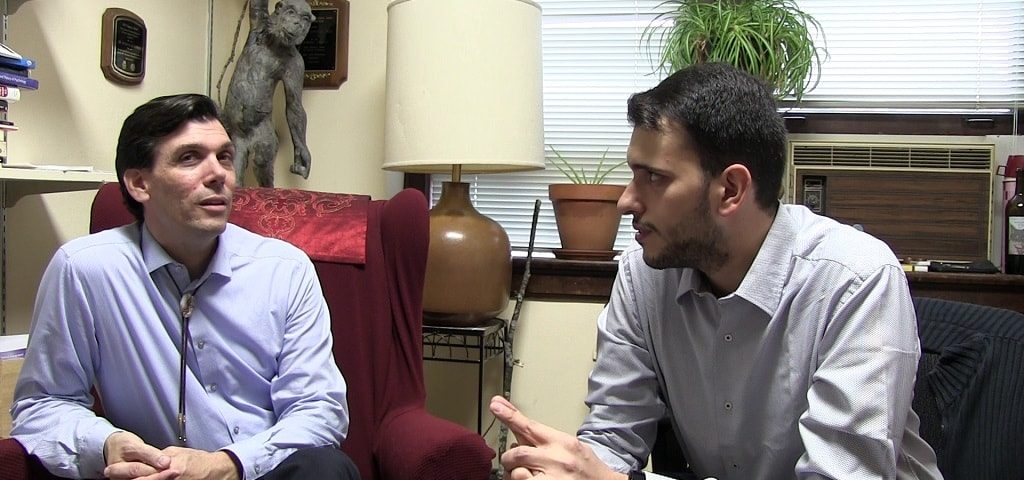
Lo stage in Virginia alla James Madison University.

L’utilizzo dell’Intrex in terapia.
La notte stellata. Rivista di psicologia e psicoterapia n° 1/2019 – RICERCA E FORMAZIONE – pag 63-64
Come misurare l’aderenza alla IRT. Intervista a Ken Critchfield.
a cura di Andrea Ferrazza,
riprese e montaggio di Andrea Ferrazza*
Parte I
Parte II
Parte III
Durante la mia permanenza negli USA, per uno stage formativo su TRI e SASB, ho avuto modo di intervistare il Prof. Ken Critchfield, della James Madison University; il Prof. Critchfield sta portando avanti il lavoro di Lorna. S. Benjamin, oltre ad essere stato suo collaboratore. Durante i 3 mesi passati insieme ho avuto la possibilità di studiare, in maniera più approfondita, le teorie che Lorna Benjamin ha esposto, più volte qui in Italia, su questa stessa rivista o che vengono applicate nella scuola Sistemica – Relazionale di Dedalus. In questo periodo di stage ho potuto affrontare anche cose più specifiche e particolari, meno note dei concetti principali, e proprio su queste mie “scoperte” ho deciso di improntare l’intervista. Per questo motivo si consiglia una visione a chi ha praticità con le teorie della TRI e della SASB, qualora non foste avvezzi a queste teorie, al seguente link potrete trovare un’intervista alla Benjamin su questa rivista.
La seguente intervista è divisa in tre parti, ognuna con un argomento specifico di discussione:
La validazione della TRI
Gli ambiti di applicazione
Aderenza al trattamento
Sicuramente è molto interessante apprendere come si arriva al prodotto finale, per questo ho chiesto al Prof. Critchfield di parlare del lavoro che c’è stato e che ha portato a definire TRI e SASB dei modelli, da poter seguire e applicare.
Nella seconda parte si analizzano alcuni possibili campi applicativi, sia in ambito psicologico che psicoterapico.
L’ultima parte invece è la più curiosa per quello che mi riguarda, ricordo ancora quando, quasi per gioco, il Professore ci assegnò il compito di “valutare” alcuni terapeuti a lavoro con i loro pazienti. Ovviamente la valutazione non serve a dire
se il terapeuta è “bravo” ma quanto aderisce al modello durante la terapia ed in questa parte dell’intervista Ken ci spiega perché viene misurata l’aderenza delterapeuta e del paziente, al modello .
Scarica la versione completa dell’articolo
During my staying in U.S.A., to attend an internship about IRT and SASB, I had the opportunity to interview Professor Ken Critchfield, from James Madison University; Prof. Critchfield is carrying on the work of Lorna S. Benjamin, being moreover a co-worker of her. During the three months spent together, I had the opportunity to study, in a deeper way, the theories either exposed by Lorna S.Benjamin several times in Italy on this magazine or applied in our treatment in Dedalus. During my internship I could deal also with more specific and particular subjects, less known that the main conceptions, and I decided to manage the interview just on these my “discoveries”. Due to this reason the vision is adviced to those who is familiar with theories of TRI and SASB. Could you be not
accustomed to those subjects, you will be able to find an interview to Mrs. Benjamin on this magazine at the following link.
The interview is divided into three parts, each one of those consting on specific topic of discussion:
Validation of IRT;
Range of application;
Adherence to treatment.
It’s really very interesting to learn how the final result is obtained, for this reason I asked Prof. Critchfield to tell about the work done to define IRT and SASB as models to be followed and applied.
In the second part are analyzed some possible application either in psychological or psychotherapeutical treatment.
But, for what I’m concerned, the last part is the most curious. I still remeber when, just about a game, the Professor asked us to “value” some therapists at work with patients. Obviously, the valutation is not aimed to state how good is the therapist but how much he follows the model during the therapy, and in this part of the interview Ken explains why the adherence of treatment related to therapist and patient, is measured .
Note
*Dott. Andrea Ferrazza , Psicologo e terapeuta sistemico relazionale in formazione presso l’Istituto
Dedalus.
© RIPRODUZIONE RISERVATA




